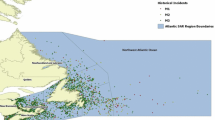Abstract
This paper examines a problem of the Canadian Coast Guard. The mission of the Coast Guard (Atlantic) is to provide assistance to vessels or persons aboard that are in distress. This piece focuses on the search & rescue mission of the Coast Guard. The two most important criteria include the average time that it takes to reach a vessel in distress, and the number of vessel incidents that can be reached within a reasonable time limit. Given that demand throughout the year is not constant but peaks during the summer season (in excess of 50% of the distress calls occur in July and August), there is a potential for congestion and the resulting inability of the Coast Guard to answer distress calls within an acceptable amount of time. In order to avoid formulating the model as a probabilistic model with all its computational difficulties, we use backup coverage as a third important concern. We model the problem of locating different types of rescue vessels along the coastline of the Maritime Provinces as an integer programming problem with three objectives, each dealing with one of the major concerns. The problem is solved given the available vessels and on the basis of incidents reported in the past. The solution is compared to the arrangement that is presently used by the Coast Guard.
Access this chapter
Tax calculation will be finalised at checkout
Purchases are for personal use only
Similar content being viewed by others
References
Canadian Coast Guard 2010–2011. Fleet Annual Report. Retrieved June 13, 2017, from http://www.ccg-gcc.gc.ca/folios/00888/docs/FAR-RAF-2010-2011-eng.pdf.
Akbari, A., Pelot, R., & Eiselt, H. A. (2017). A modular capacitated multi-objective model for maritime search and rescue location. Annals of Operations Research, July 2017. Retrieved from https://link.springer.com/content/pdf/10.1007%2Fs10479-017-2593-1.pdf.
Romero, C. (2014). Handbook of critical issues in goal programming. Oxford, UK: Pergamon Press.
Jones, D., & Tamiz, M. (2010). Practical goal programming. International Series in Operations Research and Management Science, vol. 141, Springer Science+ Business Media, New York.
Aouni, B., & Kettani, O. (2001). Goal programming model: a glorious history and a promising future. European Journal of Operational Research, 133(2), 225–231.
Church, R. L., & ReVelle, C. S. (1974). The maximal covering location problem. Papers of the Regional Science Association, 32, 101–118.
Hakimi, S. L. (1964). Optimal locations of switching centers and the absolute centers and medians of a graph. Operations Research, 12, 450–459.
ReVelle, C. S., & Swain, P. W. (1970). Central facilities location. Geographical Analysis, 2(1), 30–42.
Akbari, A., Eiselt, H. A., MacMackin, W. D., & Pelot, R. P. (2017). Determining the optimal mix and location of search and rescue vessels for the Canadian Coast Guard. International Journal of Operations and Quantitative Management, 23(2), 131–146.
Author information
Authors and Affiliations
Corresponding author
Editor information
Editors and Affiliations
Rights and permissions
Copyright information
© 2018 Springer International Publishing AG, part of Springer Nature
About this paper
Cite this paper
Eiselt, H.A., Akbari, A., Pelot, R. (2018). Multiobjective Spatial Optimization: The Canadian Coast Guard. In: Kliewer, N., Ehmke, J., Borndörfer, R. (eds) Operations Research Proceedings 2017. Operations Research Proceedings. Springer, Cham. https://doi.org/10.1007/978-3-319-89920-6_17
Download citation
DOI: https://doi.org/10.1007/978-3-319-89920-6_17
Published:
Publisher Name: Springer, Cham
Print ISBN: 978-3-319-89919-0
Online ISBN: 978-3-319-89920-6
eBook Packages: Business and ManagementBusiness and Management (R0)




